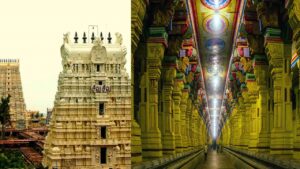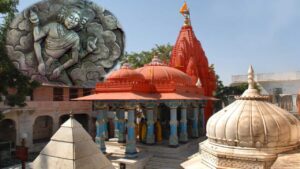Unveiling the Splendor: Exploring the Enchanting World of Jain Temple

“Incredible Secrets of Jain Temple Revealed: You Won’t Believe What Lies Inside!”
Jainism, one of the oldest religions in the world, is rooted in the principles of non-violence, truth, and non-possessiveness. With its origins in ancient India, Jainism has a rich history and a deep spiritual significance. Jain temple, also known as Derasars, play a vital role in Jain religious and cultural practices. These temples are not only places of worship but also architectural marvels that showcase intricate designs, breathtaking artwork, and a serene ambiance.

In this article, we will explore the significance of Jain temple, their design and features, the spiritual rituals performed within their sacred spaces, the exquisite artwork and sculptures adorning them, and their role as centers of learning and community engagement. We will also delve into the challenges of preserving Jain temple traditions in the face of modernity and discuss the future of these sacred structures.
The Significance of Jain Temple in Jainism
Jain temples hold immense significance for followers of Jainism as they serve as sanctuaries for spiritual practice and religious observances. These temples provide a space for devotees to connect with their inner selves, seek enlightenment, and deepen their understanding of Jain teachings. Jainism emphasizes the concept of the soul’s liberation from the cycle of birth and death, known as moksha, and Jain temples serve as a gateway to spiritual enlightenment and self-realization.
Architectural Marvels: Design and Features of Jain Temple
Jain temple are renowned for their awe-inspiring architecture, which reflects the religious and cultural values of Jainism. The design of Jain temple is rooted in ancient Indian architectural principles, characterized by intricate carvings, detailed ornamentation, and geometric patterns. These temples often feature multiple spires, domes, and intricately carved pillars, showcasing the exceptional craftsmanship of artisans from centuries past.

Sacred Spaces: Exploring the Inner Sanctum of a Jain Temple
The inner sanctum of a Jain temple, known as the garbha griha, is considered the most sacred space within the temple complex. It houses the main deity or deities worshipped by the Jain community. Devotees enter this inner sanctum to offer prayers, perform rituals, and seek blessings. The sanctum is adorned with vibrant colors, beautifully carved statues, and symbols representing Jain deities and spiritual concepts.
Intricate Artwork and Sculptures: Adorning Jain Temple
Jain temple are renowned for their exquisite artwork and sculptures, which depict various aspects of Jain philosophy, mythology, and history. These intricate sculptures are often made from marble or stone and showcase the skill and devotion of the artisans. The sculptures depict Tirthankaras (spiritual teachers) and other revered Jain figures, each intricately detailed and imbued with spiritual symbolism.

Rituals and Practices at Jain Temples: A Spiritual Journey
Jain temple are a hub of religious rituals and practices that guide followers on their spiritual journey. The rituals performed at Jain temples vary according to different sects and traditions within Jainism. These rituals may include the recitation of sacred texts, meditation, offerings of flowers and food, and the observance of fasting. Devotees actively participate in these rituals to purify their minds, cultivate virtues, and strengthen their spiritual connection.
Jain Temple Festivals: Celebrating Traditions and Devotion
Jain temple festivals are vibrant celebrations that bring the community together in devotion and merriment. These festivals commemorate significant events in Jain history and provide an opportunity for devotees to express their faith and celebrate their shared values. During these festivals, Jain temple come alive with colorful decorations, devotional singing, processions, and elaborate rituals.

Pilgrimage Destinations: Famous Jain Temple Around the World
Jainism has a global presence, and there are numerous Jain temples around the world that serve as important pilgrimage destinations for followers of the faith. Let us explore some of the notable Jain temples:
- Ranakpur Jain Temple: Located in Rajasthan, India, the Ranakpur Jain Temple is renowned for its intricate marble architecture and 1,444 exquisitely carved pillars.
- Varanga Jain Temple: Situated in Karnataka, India, the Varanga Jain Temple is known for its ancient stone carvings and its serene location atop a picturesque hill.
- Palitana Jain Temple: Located in Gujarat, India, the Palitana Jain Temple is a sacred pilgrimage site comprising of 863 marble-clad temples atop Shatrunjaya Hill.
- Dilwara Jain Temple: Situated in Mount Abu, Rajasthan, the Dilwara Jain Temple is famous for its remarkable marble craftsmanship, intricate carvings, and tranquil surroundings.
- Hutheesing Jain Temple: Situated in Ahmedabad, Gujarat, the Hutheesing Jain Temple is an architectural marvel known for its intricately carved marble facades and ornate domes.
- Girnar Jain Temple: Perched atop Mount Girnar in Gujarat, the Girnar Jain Temple complex comprises a series of temples that attract pilgrims from far and wide.
- Nareli Jain Temple: Located near Ajmer, Rajasthan, the Nareli Jain Temple boasts of a modern architectural design, featuring intricate marble carvings and a tranquil pond.
- Mount Abu Jain Temple: Situated in the scenic hill town of Mount Abu, Rajasthan, this temple complex is renowned for its serene ambiance and ancient architectural style.
- Tarangaji Jain Temple: Situated in Mehsana, Gujarat, the Tarangaji Jain Temple is famous for its magnificent stone carvings and beautifully decorated domes.
- Shahpur Jain Temple: Located in Maharashtra, India, the Shahpur Jain Temple is known for its splendid architecture, ornate carvings, and religious significance.
- Jain Temple Bangalore: The Jain temples in Bangalore, Karnataka, are notable for their architectural beauty, intricate carvings, and the peaceful atmosphere they offer to devotees.
- Jain Temple Wayanad: Situated in Kerala, India, the Jain Temple in Wayanad is a serene place of worship known for its tranquil surroundings and spiritual ambiance.
- Muktagiri Jain Temple: Nestled amidst the hills of Madhya Pradesh, India, the Muktagiri Jain Temple is famous for its natural beauty and the serenity it offers to devotees.

Jain Temples as Centers of Learning and Community Engagement
Jain temple serve as not just places of worship but also centers of learning and community engagement. They offer a platform for religious discourse, spiritual guidance, and the dissemination of Jain teachings. Jain temple often have libraries, where ancient texts and scriptures are preserved, studied, and made accessible to scholars and devotees. These temples also organize various educational and cultural programs, promoting the values of non-violence, compassion, and knowledge.
Jain Temple Preservation: Balancing Tradition and Modernity
Preserving Jain temple traditions while adapting to modernity is a delicate balance that the Jain community strives to maintain. The challenge lies in safeguarding the heritage and sanctity of these temples while making them relevant and accessible to future generations. Efforts are underway to conserve and restore ancient temples, protect delicate artwork, and promote sustainable practices to minimize the environmental impact of temple activities.

The Future of Jain Temples: Adapting to Changing Times
As we look to the future, Jain temple face the task of adapting to changing times while staying true to their core principles. With advancements in technology and the increasing globalization of society, Jain temples are exploring innovative ways to engage the younger generation and create a sense of community. Digital initiatives, interactive educational programs, and social outreach activities are being embraced to ensure the continued relevance and vibrancy of Jain temples in the modern world.
Conclusion: Embracing Spirituality at a Jain Temple
Jain temple stand as symbols of spirituality, peace, and devotion. They provide a serene sanctuary for followers of Jainism to connect with their faith, seek inner peace, and engage in religious practices. Through their magnificent architecture, intricate artwork, and rich cultural heritage, Jain temple offer a glimpse into the profound teachings and values of Jainism. By embracing the spirituality that emanates from these sacred spaces, individuals can embark on a journey of self-discovery, compassion, and enlightenment.

FAQs
1. Are Jain temples open to people of all faiths?
Yes, Jain temple are open to people of all faiths. Visitors are welcome to explore the temples, learn about Jainism, and experience the tranquility of these sacred spaces.
2. Can women enter the inner sanctum of Jain temples?
In some Jain temple, women may have restricted access to the inner sanctum. However, practices vary among different sects and regions, and many temples are becoming more inclusive by allowing equal access to all devotees.
3. Are Jain temple only found in India?
While Jainism originated in India, Jain temples can be found in various parts of the world, including countries like the United States, Canada, the United Kingdom, and East Africa, where the Jain community has a significant presence.
4. Are there any specific dress codes or guidelines to follow when visiting Jain temple?
It is advisable to dress modestly when visiting Jain temples out of respect for the religious customs and practices. It is best to wear clothes that cover the shoulders and knees.
5. Can non-Jains participate in Jain temple festivals?
Yes, non-Jains are generally welcome to participate in Jain temple festivals. These festivals provide a unique opportunity to experience Jain traditions, culture, and devotional practices.








